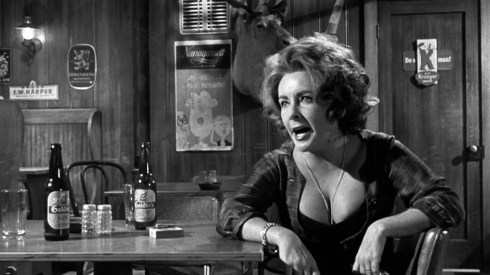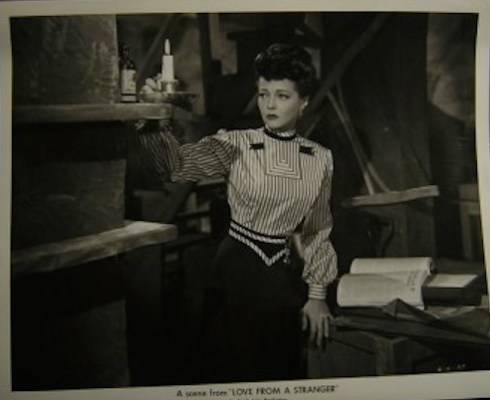BEDLAM (1946)
Bedlam 1946 is Val Lewton’s visually haunting condemnation of mental asylums. Mark Robson directs Boris Karloff in perhaps one of his most vicious roles as the sadistic Master George Sims. Challenged by Mistress Bowen (Anna Lee) for his cruelty and inhumane treatment of the inmates, Sims orchestrates her confinement to Bedlam as she tries to reform the horrible conditions of the place. Stunning and brutal, Bedlam is the most savage story in the Lewton canon. It is a wonderful appearance by character actor Ian Wolfe, who always brings a bit of perspicacity to any film.
Boris Karloff’s performance in Bedlam (1946) is a masterclass in chilling restraint and psychological menace. In my opinion, it is perhaps among his finest and most complex screen creations. As Master George Sims, Karloff trades the Gothic excesses of his more famous monsters for a quiet, brooding authority, a malevolent figure who rules the asylum with wit as sharp as his cruelty, a presence simultaneously polite and terrifying. This is highlighted in the infamous “gilded boy” dinner party, as he expresses glee and a vicious delight, striking not simply for its horror but for the way Karloff infuses Sims with chilling plausibility and hints of perverse enjoyment.
What’s mesmerizing is how Boris Karloff channels both icy calculation and flashes of wry, almost courtly charm, rendering Sims a portrait of domesticated evil by candlelight, an administrator whose sinister schemes and subtle tyranny keep the film taut with dread. Even in the climactic reversal, when the inmates turn on their tormentor, there’s an uneasy pathos to Karloff’s final moments: his gaze flickers between defiance and abject horror as retribution literally walls him in. Karloff’s turn in Bedlam is truly villainous, rather than merely misunderstood, where he transcends archetype to deliver a performance that feels eerily real, haunted, human, and disturbingly close to home. His performance feels uncomfortably familiar or relevant, resonating on a personal or societal level rather than as a distant, purely fictional level of horror. It’s not theatrics but the haunted precision of his gestures and long, deliberate silences that define the role, and elevate Bedlam itself above mere historical horror into something genuinely unsettling.
Bedlam (1946), as one of Val Lewton’s extraordinary visually poetic psychological horror films in his collection for RKO Pictures, is perhaps one of his darkest poems. Val Lewton, known for his stylish horror B-films, co-wrote the screenplay under the pseudonym Carlos Keith, maintaining his approach to horror with a focus on psychological tension and suggestive shadows rather than overt supernatural elements.
The film, which would be the last collaboration with Boris Karloff and his final film for RKO, with the great actor commanding the screen with a deranged subtlety as Master George Sims, the cruel apothecary general of St. Mary’s of Bethlehem Asylum, and Anna Lee as Nell Bowen, a spirited reformer who seeks to improve the conditions for the asylum’s inmates, and the mistreatment of mental health patients in the 18th century.
Set in 1761 London, the film was inspired by William Hogarth’s painting series “A Rake’s Progress,” with Hogarth receiving a writing credit. The story follows Nell Bowen’s efforts to reform the notorious asylum, leading to her own commitment by the sadistic Sims.
Bedlam features several dramatic scenes that highlight the cruelty of the asylum and the tension between Nell Bowen and Master Sims. One of the most shocking scenes involves the “gilded boy,” where a young inmate painted in toxic gold performs for Lord Mortimer’s (Billy House) party, only to collapse and die from the poisonous paint while the callous partygoers and wealthy patrons revel in the spectacle of the poor boy’s suffering. This scene vividly illustrates the callousness of Sims and wealthy patrons toward the inmates’ dire struggles.
The cinematography by Nicholas Musuraca contributes significantly to the film’s atmospheric quality, employing chiaroscuro lighting techniques typical of Lewton productions. The set design, utilizing the church set from The Bells of St. Mary’s (1945), adds to the film’s gothic ambiance.
THE BODY SNATCHER 1945

The Body Snatcher (1945) is a chilling horror film directed by Robert Wise and produced by Val Lewton, set in 1831 Edinburgh. Karloff gives a tour de force, nuanced performance as John Gray, a sinister cabman who moonlights as a grave robber and murderer.
The film also features the sophisticated Henry Daniell with his concrete, chiseled, austere face as Dr. MacFarlane, a physician tormented by his past and Gray’s machinations to make money any way he can. Beloved Bela Lugosi appears in the film as Joseph, a blackmailing servant, and has a notably small role, marking the last on-screen collaboration between the two horror legends.
The story, based on Robert Louis Stevenson’s work, follows Gray’s increasingly disturbing methods of procuring cadavers for Dr. MacFarlane’s medical school, leading to a psychological battle between the two men that culminates in a haunting climax.
Boris Karloff’s performance as John Gray in The Body Snatcher (1945) is a haunting embodiment of malevolent cunning and psychological depth. Karloff crafts Gray not as a mere villain but as a complex figure: a grave robber and occasional murderer who carries himself with a sinister charm that both fascinates and unsettles us to the core. His portrayal balances menace with a sly, almost sardonic humor, making Karloff’s Gray a character whose presence dominates every scene he inhabits without ever falling into caricature.
Karloff masterfully reveals the creeping rot of guilt and amorality beneath Gray’s calculated exterior. His physicality, the gaunt makeup paired with his piercing, icy stare, heightens the sense of impending doom that accompanies his every stalking move. Much like Bedlam, it’s a blend of cruelty and charisma, underscored by sudden bursts of violence that shock precisely because they feel disturbingly real and not exaggerated.
The performance benefits from Karloff’s ability to convey layered motivations; Gray oscillates between ruthless pragmatism and an eerie, almost perverse delight in his grim trade. Karloff’s Gray is not just a dark presence but a pivotal force that personifies the film’s exploration of moral decay and desperation amid the grim conditions of early 19th-century Edinburgh.
Ultimately, it’s not hard to see that Karloff’s Gray is a magnificent study in villainy, one that is chilling because it feels organic, something that Boris Karloff is a master at cultivating, crafted with a precision that transforms a simple tale of grave robbing into a psychological thriller with a lingering emotional punch. It’s a performance that showcases Karloff’s range beyond his iconic monsters, marking The Body Snatcher as one of the dark gems in his storied career.
Some key scenes include the murder of the young street singer, which highlights Gray’s ruthlessness. Gray’s tormenting of Dr. MacFarlane in the pub, revealing their complex history, and the chilling carriage ride finale, where MacFarlane hallucinates Gray’s corpse coming to life. Robert Wise’s direction and Lewton’s emphasis on the pyshcological terror rather than explicit horror fix this in his legacy as a stunning masterpiece, a film that explores the ethical dilemma faced by medical schools in the 1830s when legal cadavers were scarce. This shortage led to a grim trade in illegally obtained bodies by graverobbing, blurring the lines between scientific progress and criminal activity. The story draws inspiration from the real-life Burke and Hare murders of 1828, which also adds a layer of authenticity to the narrative.
#12 down, only 138 to go! Your EverLovin’ Joey, formally & affectionately known as MonsterGirl!




































































![Anna Lucasta (1958) | Pers: Eartha Kitt, Sammy Davis Jr | Dir: Arnold Laven | Ref: ANN040AE | Photo Credit: [ United Artists / The Kobal Collection ] | Editorial use only related to cinema, television and personalities. Not for cover use, advertising or fictional works without specific prior agreement](https://i0.wp.com/thelastdrivein.com/wp-content/uploads/2015/07/tumblr_lvnaeyvi341r1a8w8o1_500.jpg?resize=490%2C589&ssl=1)

























































































































































